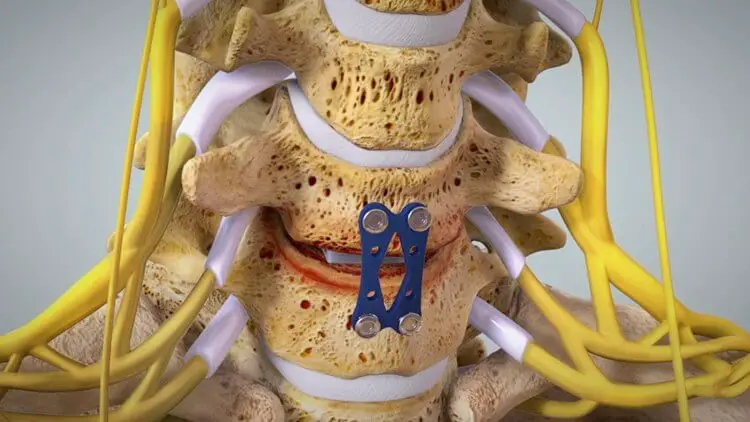Your doctor might suggest a 90% cervical spine surgery success rate, but another doctor might quote a different value. This is because there are no set criteria for evaluating the success rate of spine surgery.
Probably the pain and discomfort even after the surgery continue and there are high chances of failed back fusion syndrome as well. However, in most cases, the cervical spine surgery success rate is high.
Let’s highlight the main concerns regarding the ACDF surgery success rate. Plus, we’ll also discuss the three-level cervical fusion recovery time and ACDF recovery tips and tricks. So let’s dig in!
Cervical Spine Surgery Success Rate
Every doctor or surgeon has his definitions of the term success. Different researches say different things about the cervical spine surgery success rate.
Besides, the success rate of any surgery depends on the patient’s health. And the same goes for cervical spine surgery.
However, there are average values that we’ll consider standard here. It’s not documented, but we will go with what most physicians say.
Average Success Rate of Cervical Spine Surgery
Note that the cervical spine surgery success rate decreases gradually with each passing year.
According to study reports, there is a 37% increased risk of revision lumbar surgery in the future due to adjacent disc compression after about 15 years.
Moreover, multilevel fusion has a 60% cervical spine surgery success rate, meaning it requires reoperation in 40% of cases.
And many patients are hospitalized due to increased chances of complications and a high mortality rate.
Plus the patients who use opioids for a prolonged time are at high risk of going through another spinal fusion surgery after a year. This makes up around 33% of patients who would be needing repeated spine surgery later in life.
Long-term Effects of Cervical Fusion
Following are the long-term effects of cervical fusion compromising on the cervical spine surgery success rate.
- There are high risks of spinal disability, chronic pain, and loosening of screws after the surgery.
- Moreover, some patients never get a chance to get back to work.
- Some patients might have recurring spinal stenosis and all those conditions for which the patient had the surgery in the first place.
- You might experience muscle pain after cervical fusion surgery.
- Most commonly the fused spine puts pressure on the adjacent spine resulting in adjacent disc pathology. Which means you have to be careful with every movement.
All these factors reduce the spine surgery success rate to a low level requiring another surgery after a few years.
Anterior Cervical Discectomy and Fusion (ACDF) Surgery Recovery Time

What does ACDF mean?
It is a surgery of the neck which involves the removal of a disc or a bony lamina to decrease the pressure on nearby nerves and spine.
Following is the ACDF surgery success rate based on recent researches;
- In around 90 to 100 percent of cases of arm pain, ACDF has proved to be successful.
- Whereas, it has a success rate of 70 to 80 percent in patients who had surgery for neck pain.
ACDF Recovery Tips

However, if you don’t want to be among the minority with failed surgery, you can follow these ACDF recovery tips to help your doctor in making the surgery successful.
- Walk for short distances, at least for one or two minutes every day.
- Do not keep your neck completely immobilized.
- Wear a cervical brace for support and to restrict the neck movement, especially when in the car or when you are working.
- Regularly visit your physician for ACDF post-op care.
Restrictions After ACDF
Note: Your doctor would recommend what’s best for you. And he might as well advise a few restrictions after ACDF surgery that you must follow blindly.
Following are the things to keep in mind for post-op care.
- Avoid sudden movement of the neck.
- Avoid bumpy rides or driving for the first few months.
- Bending the neck is strictly forbidden.
- Avoid heavy lifting. Apart from that, there are a few stenosis exercises to avoid that will rule out the need for surgery once and for all.
Note: The cervical spinal fusion recovery time is of four to six weeks in general. However, the post-op care period lasts for one to two years maximum.
So during the recovery period, make sure to follow your physician’s instructions to prevent further complications.
ACDF Complications
Even though there are very low chances of ACDF complications, however, if you weren’t careful enough during the post-op period, there are high chances of arising complications later in life.
- Difficulty in swallowing with an associated feeling of breathlessness.
- Neck and shoulder pain.
- Restrictive joints if you don’t mobilize them at the right time.
- Severe headache.
- Infection on the incision site.
These were the major factors negatively affecting the cervical spine surgery success rate. Mind you, it was only about the cervical surgery.
Following is the overall data of spinal fusion surgery success rate, and fortunately, it’s mostly in our favor.
Spinal Fusion Surgery Success Rate

If we go from highest to lowest, spinal fusion surgery has the highest success rate with around 98% of surgeries requiring no revisions later in life.
After the spinal fusion surgery comes discectomy. The term simply means the removal of discs and is sometimes done along with fusion surgery at the end. And around 90% of discectomies result in success with only a few facing long-term side effects.
Laminectomy is another option, especially for people with bony spurs in the spine. However, since in these patients, a large portion of the spine is removed, hence, the resulting success rate drops down to 80% in total (which is not bad either, if we may be honest).
FAQs
An average recovery time resulting in an increased cervical spine surgery success rate is around four to six months.
This means both the two and three-level cervical fusion has a recovery time of six months maximum.
However, you can do light chores in the initial days, that is, from four to six weeks. But you have to give at least six months post-surgery to achieve full recovery.
The most common symptom is the additional pain on top of the existing pain. And the nature of pain is usually sharp with a needle-like sensation.
Conclusion
So that was all about cervical spine surgery success rate and complications related to the surgery. The take-home point is, you need not worry if you are opting for cervical spine surgery.
As we have seen that in most cases the spinal fusion surgery success rate is high. Perhaps, you should consult your doctor first as the healing mechanism and recovery time also varies from person to person.
